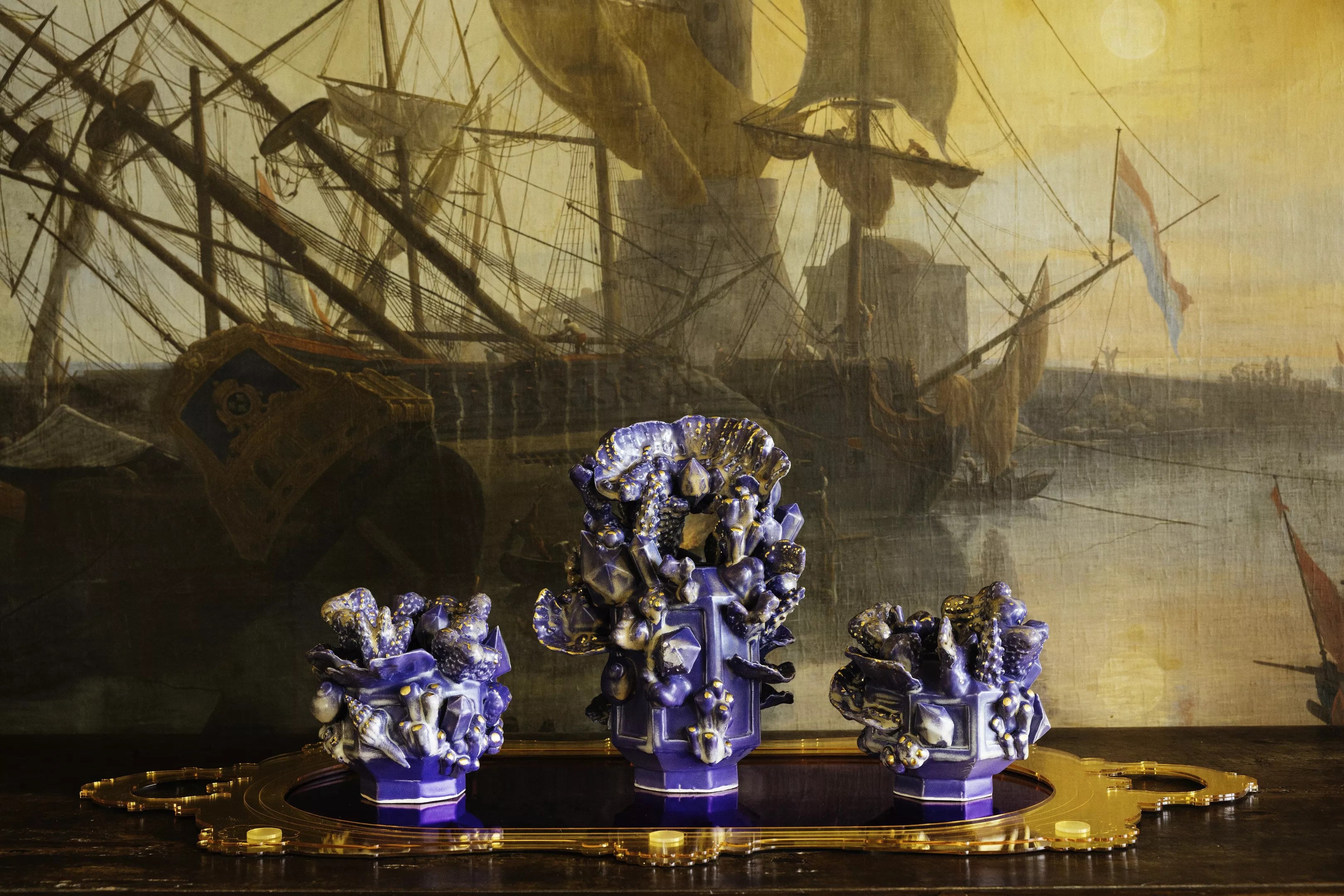
Photo by Tracy & Martin Photo Co.

Audio By Carbonatix
It’s long been a goal of sculptor Lauren Shapiro to work at Vizcaya Museum & Gardens, a venue she calls a dream place for an artist.
The house turned museum contains a blend of diverse periods and artistic styles, including baroque, Spanish influence, and neoclassical, among others. “The building itself is kind of like a mishmash of these different types of styles and materials,” she tells New Times in an interview at the estate.
Last year, the Contemporary Arts Program at Vizcaya commissioned the Broward native to create three unique, site-specific works of art for the museum. The resulting installation, titled Pastiche, is on display through May 25.
“Pastiche is essentially the combination of disparate elements to make something new,” she explains, standing up from a stone bench within the Vizcaya Museum & Gardens’ main house. The stone, concrete, marble, and coral in the entrance foyer make the area feel colder than it should. The lavish greenery of the space counteracts that coldness, adding some life back into the 109-year-old former home of James Deering.
Will you step up to support New Times this year?
At New Times, we’re small and scrappy — and we make the most of every dollar from our supporters. Right now, we’re $16,750 away from reaching our December 31 goal of $30,000. If you’ve ever learned something new, stayed informed, or felt more connected because of New Times, now’s the time to give back.
Shapiro’s installation coincides with what would have been the 150th birthday of Vizcaya’s late artistic director, Paul Chalfin. The art historian worked for Deering during the construction of the former residence, then known as Villa Vizcaya, in the 1910s. Chalfin was involved in all aspects of design, from curating and purchasing art for the property to naming its rooms and even influencing its overall architecture.
Shapiro speaks of Chalfin with admiration: “We were thinking about the exhibition in terms of what [he might] commission if he were alive today.”
“He was trying to create different worlds in each of the rooms,” she adds. “So, as you went into each of the rooms, it was a unique experience.”
Shapiro spent hours roaming the museum’s stone halls and warm gardens to find the perfect part of the house to inspire her pieces and display them. She strategically chose three of its most public spaces – rooms that were open and allowed for more foot traffic while granting increased visibility to her pieces.

One of Shapiro’s sculptures incorporates Pepper’s ghost, an optical illusion.
Photo by Pedro Wazzan
The first piece is inside the Reception Room. To find it, Shapiro makes a sharp turn and walks through an archway, passes a collection of books encased behind glass, and goes into a large viewing room. A jaw-dropping crystal chandelier hangs overhead, and an antique piano sits in the center with tables and chairs spread about.
Placed on a nondescript wooden table is a remarkable sculpture bursting with ceramic orchids. It’s elevated on a piece of mirrored plexiglass and contains a glass-blown dome with an LED projection of a dancing orchid looping inside its frame. “The illusion is called ‘Pepper’s ghost,'” Shapiro says proudly. “It’s a parlor trick from the 1800s that would create an old-school hologram.”
The piece is so subtle yet singularly stunning that it feels like a natural part of the room, like it’s always been there.
Another room that attracted Shapiro’s attention is the Enclosed Loggia, tucked away toward the back of the main house. The large, stained-glass windows on one end of the room are striking. Purple, yellow, and blue hues dance around the floor as the sun’s rays beam through.
Those fanciful colors inspired the ceramic artist’s second installation piece, which consists of two matching Victorian lamps placed on opposite ends of the room. The exterior of the vessel depicts sprawling orchids and seahorses.
“In my work, I use a lot of molds, and I go out into nature, and I collect different types of textures,” says Shapiro. For the pieces featured in Pastiche, she took 3D scans of orchids from the Vizcaya greenhouse to incorporate more elements of the house into the site-specific works.

Tea at Sunset is made from coral molds and painted a beautiful lapis blue.
Photo by Pedro Wazzan
An avid diver, Shapiro also takes 3D scans of what she finds underwater, including coral reefs. For her third piece, located on the second floor of the house in the Breakfast Room, she used coral molds to create a set of three sculptures meant to represent a tea set.
“After doing monumental public works, I was really excited for the opportunity to create design objects that would almost fit into these smaller spaces,” she says. ‘It’s also about getting people to slow down and pay attention to what’s around us and to, obviously, care about these environments and care for them.”
Shapiro grew up near the Everglades, which explains her interest in Florida’s natural environment. Her work is heavily influenced by both nature and human experience, including technology. Her mold-making and ceramic practice currently lives out of the Bakehouse Art Complex, where she not only creates but works to educate the next generation of ceramic artists.
“I can’t escape the teaching component,” she says with a smile, her blue eyes brightening. “I’m constantly reaching and shepherding artists…that’s my contribution to the community.”
Pastiche. On view through Sunday, May 25, at Vizcaya Museum & Gardens, 3251 S. Miami Ave., Miami; 305-250-9133; vizcaya.org. Museum entrance costs $25 for adults and $10 for kids.